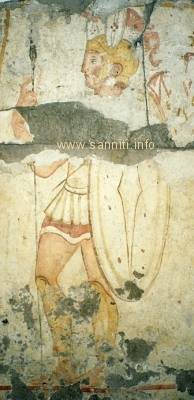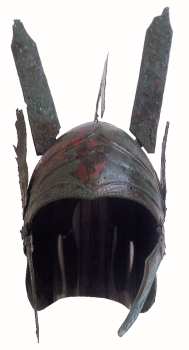No Kidding,
really,
Giovanni Battista Giani - Battaglia del Ticino tra Annibale e Scipione (1824)
Lo stesso Livio poi col dire che l'esercito Romano passando il Ticino, traductus est in agrum Insubrium,....popoli dall'una all'altra sponda; essendo notissimo che gi' Insubri abitavano tra l' Adda ed il Ticino, inoltrati anche al di là di questo fiume
TRANSLATION -
The same Livio (Livy) then by saying that the Roman army crossing the Ticino, leading the field in the agrum Insubrium,....peoples from one to the other shore; being well-known that the Insubres inhabited between the 'Adda and Ticino, also forwarded beyond this river
Tabula Peutingeriana - ~500AD -
Roman map
[
Insubres - between Tessin - Adda - Oglio]
Polybius - Histories (focus: 225 BC)
The first settlers at the eastern extremity,a near the source of the Po, were the Laevi and Lebecii, after them the Insubres, the largest tribe of all, and next these, on the banks of the river, the Cenomani
John T. Koch - The Celts: History, Life, and Culture (2012)
The area occupied by the Golasecca culture is roughly consistent with the Celtic peoples of the Insubres, Oromobii, and Lepontii mentioned in classical literature.
Thats were History and Archaeology go hand in hand;
Insubres and the Golasecca-culture area
So its safe to say that the Insubres dwelt between Tessin and Adda (a good part of Lombardy) and were def. one of the largest tribes.
The Insubres
Matthias Koch - Die Alpen-Etrusker (1853)
Auffallend bleibt jedoch immer, dass in dem Insubrer-Namen der Umbrer-Name steckt. Polybius, der Erste, welcher die Insubrer nennt, schreibt oi'Iσομβροι , und 'Oμροι und 'Oμßρixoi heissen bei den Griechen die Umbrer,
TRANSLATION -
Strikingly, however, always remains that the Umbrians name is in the Insubres name. Polybius, the first who called the Insubres, writes oi'Iσομβροι, and 'Oμροι and 'Oμßρixoi called by the Greeks the Umbrians,
Edward Gibbon - Miscellaneous Vol.5 (1814)
I reckoned the Insubres among the Gauls, on the authority of all the ancients;....Polybius indeed calls them Isombri, which in Celtic signifies the Lower Ombri. But Polybius acknowledges them for Gauls;
Sir William Smith - Dictionary of Greek and Roman Geography (1861)
But Livy has not explained the origin of the Insubres; and if the Insubres were in North Italy before this invasion, and were a Celtic people, they must have come in a former immigration; and if Is-umbri is the genuine form of the word, we may assume that they were Umbri, who had long been settled in the basin of the Po.
Christian Keferstein - Ansichten über die keltischen Alterthümer Vol.2 (1849)
Die Olombri (von ol im Keltischen hoch) bewohnten, die Gebirge, die Isombri oder (Insubres (von is im Keltischen niedrig) die Ebenen und hatten Mailand zum Mittelpunkt, die Vilombri (von bei das Ufer) die Ufergegenden, das Umbria am adriatischen Meere, im heutigen Kirchenstaate, war ein sehr blähendes Land, mit 358 Städten, das etwa 4 Jahrhunderte vor Roms Erbauung sehr mächtig war; die Umbrer verbreiteten sich sehr weit, auf der Ostseite Italiens durch einen Theil von Etrurien und bis über die Tiber; zu ihnen gehörten die Sabini (nach Dionys. von Halicarnass), auch die Aborigines in Latinm, die auch (nach Ammian. Marcell. I. 15. 9.) als Kelten oder Galater bezeichnet werden.
TRANSLATION -
The Olombri inhabited (ol in Celtic high), the mountains, the Isombri or (Insubres (is the Celtic low), the plains and had Mailand (Mediolanum) as their center, the Vilombri (of at the shore) the waterfronts, the Umbria on the Adriatic sea in today's Church state, was a very packed country, with 358 cities, which was about 4 centuries before Rome edification very powerful, and the Umbrians spread very far, on the east side of Italy by a part of Etruria and beyond the Tiber; of them were the Sabini (by Dionysius. Halicarnass), the Aborigines in Latium, which are also known (by Ammianus. Marcell. I. 15 9) as Celts or Galatians.
The Insubres are just [Is-Umbri] low-land Umbrians.
all of this is of course supported by:
Dionysius - The Roman Antiquities (29 BC)
The Umbri inhabited a great many other parts of Italy, and were an exceeding great, and ancient people.
Pliny - Natural History (79 AD)
The race of the Umbri is considered the oldest in Italy. —(C. Plin. lib. ii. Nat. Hist. c. 14.)
James Cowles Prichard - Researches into the physical History of Mankind: Vol.3 (1841)
Dionysius cites one Xenodotus of Troezene, who wrote the history of the Umbrians. According to him the Sabines were originally an Umbrian people,
also important to note:
Henry Malden - History of Rome (1830)
It is possible however that the Symbri [sYMBRI], whom Strabo mentions as a small community above the Veneti, may have been a tribe detached from the Umbrians, or left behind in the course of national migration.
Anymore Questions!












